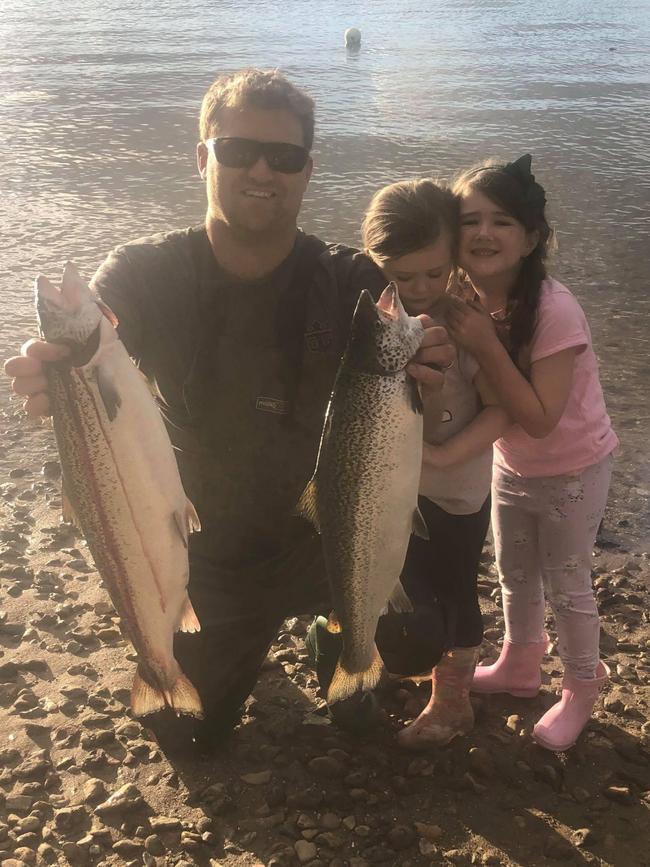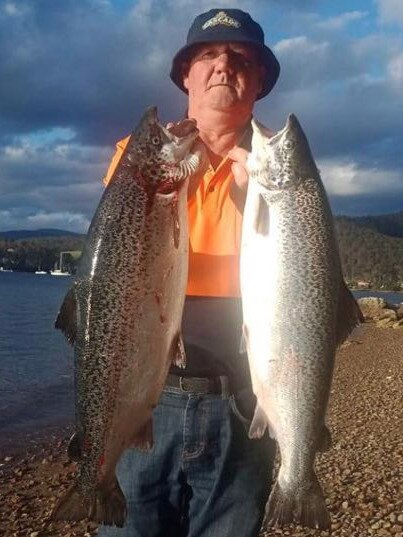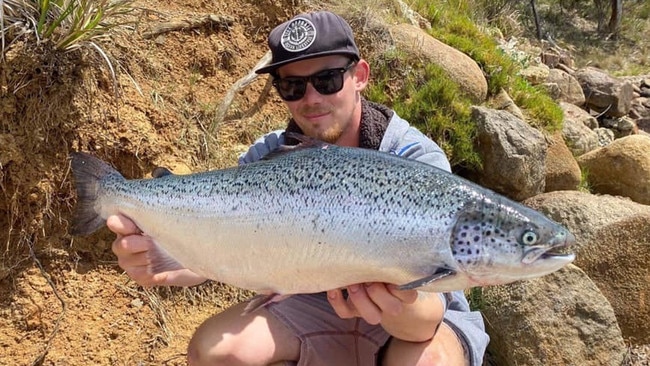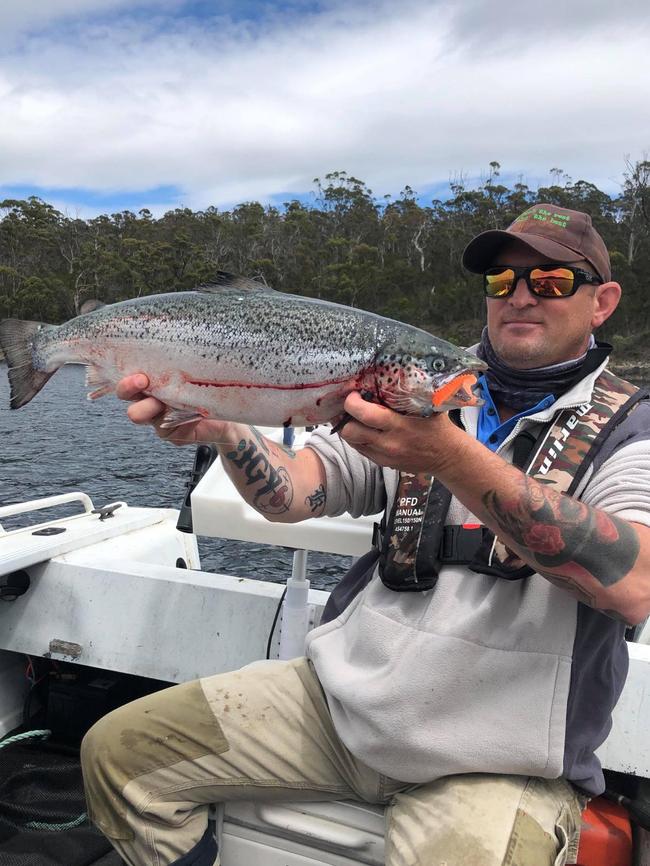Interactive map: Where to catch 50,000 escaped Huon salmon
Local fishing shops are reporting a huge run of customers after news of 50,000 salmon escaping a major farm into the Huon River. WHERE + HOW THEY ESCAPED >>
Tasmania
Don't miss out on the headlines from Tasmania. Followed categories will be added to My News.
- ‘I can’t change the past, but I can change the future’
- Nurse kept disturbing photos of patients at his home
A FISHING frenzy has hit the state as keen anglers try their hand at hooking an escaped salmon.
More than 50,000 4kg Atlantic salmon escaped from Huon Aquaculture in the early hours of Monday morning after a fire damaged pen infrastructure in the Channel.
Neil Thomas, of Franklin Marine, said despite salmon not taking lures very well, there had been a massive influx in customers popping in to the fishing shop to gear up before heading out.
“I think the whole Huon Valley is out there fishing at the moment,” he said.
“It’s such a massive thing.
“I think you could walk on water out there — either on all the fish or on all the boats out there!”


Mr Thomas said it was devastating for Huon Aquaculture, but with the fish usually going for about $100 each it was an incredible opportunity for Tasmanians.
Fisheries Tasmania said anglers were reporting the large salmon were providing excellent fishing. It reminded people that the bag limit was 12, possession limit 24 and there was no boat limit, they said.
“You cannot sell, buy, barter or raffle recreationally caught fish but you are allowed to give your catch away.”
Mercury readers have reported catching the salmon near Petcheys Bay, Waterloo Bay, Sturges Bay, near Cygnet at Gardeners Bay, at Deep Bay, off Partridge Island and near Garden Island.
Some have raised concerns over the potential environmental impacts of the escape.
Neighbours of Fish Farming president Peter George said beyond the immediate impact on the living marine environment, there was potential for long-term damage if the salmon were to establish itself in our river systems.
Environment Tasmania strategy director Laura Kelly said they were relieved to hear no staff were hurt in the fire.
“But it is irresponsible of the company to suggest this won’t hurt the environment,” she said.
Huon Aquaculture chief executive Peter Bender said studies of previous fish escapes and a 2018 IMAS study indicated it was unlikely the escaped salmon would have any impact on the native marine fauna.
“Plus escaped salmon typically don’t last long, unfortunately — what the seals don’t get, the fishermen quickly do.”
The Great Salmon Escape | Interactive map
The Mercury has compiled an interactive map of reported catches, as anglers rush to fill their eskies after news broke of the escape.
The blue ‘fish’ icons are where anglers have reported to have caught some of the 4kg Atlantic salmon, north of where the salmon escaped near Zuidpool Rock (pink star icon).
Have you caught a salmon in a spot not listed on the map? Leave a comment below of where you caught it and we’ll add it to the hotspot map.
“We are estimating that we have lost between 50,000 – 52,000 4kg fish and in accordance with our reporting requirements, we have notified MAST, EPA and DPIPWE Marine Farm Branch,” Huon Aquaculture chief executive Peter Bender said.
Mr Bender said calm weather allowed crews to fetch any pen components that had come adrift during the fire.
He said it was the first time in 35 years of farming the company had an electrical fire on a fish pen.
“The cause has baffled us,” he said.
“An investigation into the cause of the fire is underway and we are not ruling anything out at this early stage, and we encourage anyone who saw the fire to contact us.”
Mr Bender said studies of previous fish escapes along with the 2018 IMAS survey indicated it was unlikely the escaped salmon would have significant impact on native marine fauna.
“The IMAS survey was consistent with previous studies here and overseas where farmed salmon generally don’t appear to feed on native species as they are typically used to feeding on fish pellets.
“Tasmania has no native salmonids so there is no impact on wild genetic stocks (a problem in some northern hemisphere countries) plus escaped salmon typically don’t last long, unfortunately, what the seals don’t get, the fisherman quickly do”,
Tasmanian fisherman Carl Hyland said he imagined local anglers would pounce on the opportunity for a local catch.

“Whole fish like that can attract a price tag of about $100,” he said.
“Overall most recreational anglers would be very happy especially at this time of year with Christmas approaching. It’s a boon for local anglers but a ‘bummer’ for the salmon company.”
Mr Hyland, who is based in the state’s North, said he would have “jumped at the chance” for a fish in the Channel had he been nearby.
Veteran angler shares top tips
A TASMANIAN fisherman has spilled the beans on what it takes to land a monster catch.
Veteran fisher Dave Condon who has fished for salmon in the Huon for years said there is a few tips he lives by when attempting to catch salmon in local waters.
It comes after 52,000 4kg salmon escaped a Huon Aquaculture salmon pen on Monday when a fire broke out on pen infrastructure in the Channel.
“You can use a net in that area but you need to remember there’s a bag limit of 12 fish in marine waters. There is no size limit though,” he said.

“What I recommend is using soft plastics. I use Moore soft plastics which is a locally-made kind and I have found these are very successful in pumpkin seed colour, white and bright pink.”
Mr Condon said the best size soft plastic he uses to land sizeable salmon was 3-4 inches.
He predicted a reef at Zuidpool Rock as the best place to fish for the escaped salmon.
“When they have escaped in the past they’ve been there and they do eventually come into the Huon River and behind the rapids of Judbury,” he said.
“They like to head to fresh-running water and I expect they will be there in the next day or two in the Huonville area. I dare say people will be targeting them.”
Mr Condon said his biggest salmon using soft plastics was 10kg.


